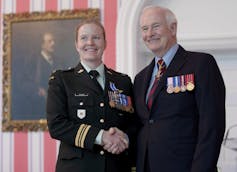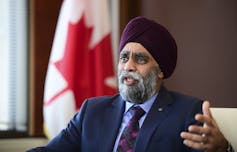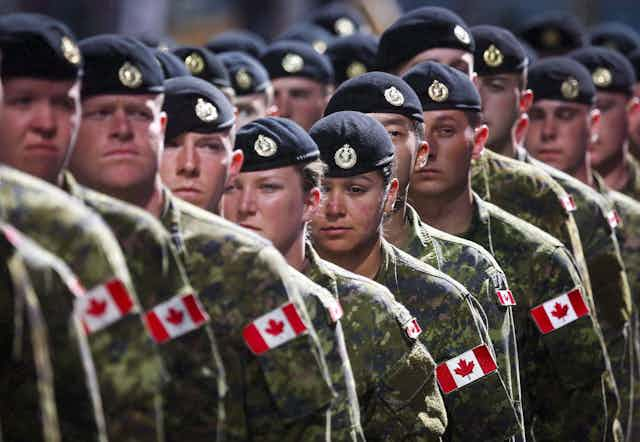In the wake of the #MeToo movement, both public and private institutions are finally grappling with the insidiousness of sexual assault and harassment within their confines.
It therefore comes as no surprise that the Canadian military, a male-dominated institution, has been plagued by a number of scandals involving high-ranking officials. While the multiple public disclosures on this front are an important step in bringing about change, the responses to date have largely served to obscure the systemic nature of sexual violence in organizations.
Read more: Sexual misconduct, abuse of power, adultery and secrecy: What I witnessed in Canada’s military
In March, Defence Minister Harjit Sajjan testified to the House of Commons defence committee, insisting that adding more women to the Canadian military was a proven way of challenging toxic masculinity and creating culture change. Just days later, Lt.-Col. Eleanor Taylor, deputy commander of the 36th Brigade Group, resigned her post amid persistent allegations of sexual misconduct among high-ranking military officials.

Sajjan argued that “we know” a strategy of having more women “at the table” works. But Taylor’s resignation letter noted: “Some senior leaders are unwilling or (perhaps unable) to recognize that their behaviour is harmful both to the victim and to the team” and “some recognize the harm but believe they can keep their behaviour secret. Perhaps worst of all are those in authority, who should know better, but lack the courage and tools to confront the systemic issue.”
Sajjan seems to view the military, like any organization, as simply the sum of its parts. He evidently believes changes to workforce composition will lead to cultural change.
But Taylor’s experience reveals the limits of this thinking:
“I have been both a victim of, and participant in, this damaging cycle of silence, and I am proud of neither.”
Taylor’s disclosure as both victim and participant in abuses of power and sexual exploitation is significant. As her statements make clear, more women do not guarantee more equity.
Inclusion not synonymous with change
As we observed in our opinion piece published in the Ottawa Citizen in March 2021, Sajjan’s comments reflect the dominant approach to gender equality policy in Canada.

The goal is to simply include more women without addressing underlying power structures and practices. But these are the very structures that have contributed to inequity and rampant abuses of power.
Research demonstrates that while adding women and other marginalized groups to existing power structures and practices is necessary for inclusion and equity, it is by no means synonymous with change.
As Malinda Smith, a political science professor at the University of Calgary and co-author of The Equity Myth: Racialization and Indigeneity at Canadian Universities, argues: “You can have diversity, but those diverse individuals and groups can be treated inequitably. People can be segregated, marginalized; they can be on the outside looking in. It’s not one size fits all.”
One way of engaging more deeply on gender equality is to understand gender not simply as identity but as a central, structural concept for both individuals and organizations.
Focusing instead on how gender plays out in our society and institutions takes us beyond counting women as a measure of change, and instead centres on the politics of gender.
Cynthia Enloe, an internationally renowned feminist and militarization scholar, has argued: “Gender makes the world go round.” The ideas we have about gender drives everything from decision-making, to alliances and hostilities.
“It allows for certain kinds of structures to seem normal and therefore unchallengeable,” Enloe says.
These structures also often remain “referentially transparent,” as noted by American sociologists Barbara Reskin and Heidi Hartmann.
That means our ideas about gender make certain kinds of structures and hierarchies seem normal, efficient and unchangeable at community, national and international levels. Enloe explains:
“That normalization is a political process that is driven — not entirely, but in large part — by assumptions of politics and decisions around masculinity and femininity.”
Backlash is possible
In fact, efforts to create change through increased numbers can result in a backlash or “aggrieved entitlement” and further entrench cultures of exclusion rather than transform them.
Research into military and paramilitary organizations, including the RCMP, has demonstrated that as more women enter male-dominated and masculinized professions, the rates of sexual assault, harassment and violence in those professions often increase.

Change will only come from addressing organizational structures that are informed by and reinforce ideas about gender.
This requires not only efforts to increase numbers of women and other marginalized people, though that is certainly necessary, but also changing leadership and decision-making practices.
Read more: Defund the police? Instead, end toxic masculinity and ‘warrior cops’
Change needs to be a priority among organizational leadership, and leadership and decision-making roles need to be more diverse. In addition, decisions need to be based on analyses and processes that give voice to women and other under-represented groups.
Organizational culture and workplace norms also have to reflect the diverse needs of team members, including tackling head-on the toxic masculinity that often pervades military and paramilitary organizations. Without attending to these structural dimensions that contribute to inequity and abuses of power, it is unlikely that change will come.

